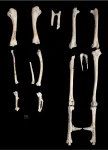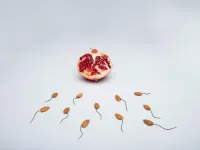(Press-News.org) Bad sleep causes severe health issues and affects our ability to concentrate, memorize, and cope with challenging situations. Individuals with neurodevelopmental disorders such as autism and intellectual disability, frequently suffer from sleep problems. However, little is known about their underlying mechanisms. In Science Advances, a Dutch-American research team, coordinated by Radboudumc, now describes how these problems can arise. Mimicking two genetic causes of autism in fruit flies, they uncovered that flies show the same sleep problems as the patients, and that the disturbed sleep is caused by high levels of serotonin - also frequently observed in autism. Moreover, they found that the origin of high serotonin and sleep problems resides on the glial cells of the blood-brain barrier. This completely new information sheds light on sleep problems in humans and even suggests a possible treatment.
Poor sleep seriously affects cognitive abilities and quality of life. Already vulnerable individuals with autism and related neurodevelopmental disorders suffer particularly often from sleep disturbance, and with them their families as well. Yet, hardly any research has been conducted into the underlying mechanisms of these sleep problems. A Dutch-American team of researchers coordinated by professor Annette Schenck, in collaboration with professor Tjitske Kleefstra - both at Radboudumc - has investigated this problem in humans as well as in fruit flies. Schenck: "We first looked very closely at the sleep problems in two specific patient groups with neurodevelopmental disorders. They have mutations in the CHD8 gene, a leading genetic cause of autism, or in a closely related gene, CHD7, giving raise to CHARGE syndrome. We see that the bad sleep in these disorders particularly comes from problems falling and staying asleep, which causes night awakenings and low sleep quality. We call this problem sleep fragmentation. It is frequent in autism in general, but even more frequent in the individuals with mutations in CHD8 or CHD7. According to affected families, these sleep problems are one of their biggest problems in daily life management. This motivated us to study sleep disturbances, in context of these genes and disorders further".
From humans to fruit flies
To be able to look into brains, investigate problems, and test interventions, researchers turn to animal models. In the fruit fly, an animal model that has led to multiple Nobel prizes, CHD8 and CHD7 are represented by a single gene termed kismet. Mutations in kismet in the fruit fly can therefore tell a lot about mutations in those two "orthologous" genes in humans. Mireia Coll-Tané, researcher in Schenck's group and lead author of the study published in Science Advances: "We see that flies with mutations in kismet have problems staying asleep, waking up during night extremely frequently. They show the same characteristics that we see in people with mutations in CHD8 and CHD7."
Not the neurons, but the glial cells
Schenck's research group is specialized in fruit fly research on genes causing neurodevelopmental disorders. They routinely generate flies with mutations in genes that correspond to the disease genes, and look at changes in behaviors or other properties of the nervous system that are present in both humans and flies. Schenck: "when Mireia found the sleep fragmentation to be present also in flies, we knew that can use our model with all of its advantages to find out where this problem comes from". They found that kismet is important for good sleep of adult flies but also already earlier during development, and that the adult sleep defects result from decreased kismet during the developmental period. Coll-Tané: "We also found that kismet was not important in the neurons, the cells that are classically seen to regulate behavior, but in the other main cell type present in the brain: the glial cells. Glia have many important functions, such as supporting neurons, cleaning up waste and contributing to the blood-brain barrier. We saw that kismet is important, already in early development, in a group of only 300 glial cells that form the blood-brain barrier in the fly. They are the origin of the sleep fragmentation."
Surprising role for serotonin
Often the neurotransmitter dopamine plays a role in sleeping problems. This study also looked at this, but dopamine levels were normal. In contrast, the neurotransmitter serotonin appeared to be important. Coll-Tané: "When we reduce kismet specifically in glia, we found the concentration of serotonin in fruit fly heads to be doubled. This is a very interesting finding because increased serotonin, also referred to as hyperserotonemia, is one of the most commonly found biomarkers in autism." In a series of further genetic and drug experiments, the researchers provided evidence that the increased serotonin levels during development are responsible for kismet's sleep fragmentation. Coll-Tané: "Our work has linked a leading genetic cause of autism to a frequent biomarker and an important clinical complaint in autism. We propose that our identified mechanism is relevant to autism more widely".
Future therapy?
An important question is whether the sleep problems associated with the developmental disorders can be tackled after all. It must be a treatment that works in adults (ie after development), and that is non-invasive and safe. Schenck: "Our co-authors in Philadelphia recently developed sleep-restriction therapy for fruit flies - SRT for short. An equivalent intervention is widely used in humans, in otherwise healthy individuals with insomnia. But it is rarely applied to autism and neurodevelopmental disorders, perhaps because sleep defects are considered an inevitable consequence of the genetic mutations. But the behavioral therapy succeeded! A simple light regime mimicking shorter nights made the flies sleeping better, effectively reversing the sleep fragmentation. And this despite that the origin of the problems lies earlier in development."
Further research in humans
With the article in Science Advances, further research in humans is obvious. Clinical geneticist Kleefstra: "We have already shown in our article that CHD7 and CHD8 are expressed in the human blood-brain barrier, both during development and adulthood. Now we aim to collect further clinical data and apply SRT to these patients, in close collaboration with the expert sleep clinic Kempenhaeghe in Heeze. Together, we are expanding our 'human-to-fruit-fly-and-back' strategy to a number of other disorders." Clearly, the path to more fascinating sleep research in flies and humans is up for grabs with this publication.
INFORMATION:
Paper in Science Advances: The CHD8/CHD7/Kismet family links blood-brain barrier glia and serotonin to ASD-associated sleep defects - Mireia Coll-Tané, Naihua N. Gong, Samuel J. Belfer, Lara V. van Renssen, Evangeline C. Kurtz-Nelson, Milan Szuperak, Ilse Eidhof, Boyd van Reijmersdal, Isabel Terwindt, Jaclyn Durkin, Michel M. M. Verheij, Chang N. Kim, Caitlin M. Hudac, Tomasz J. Nowakowski, Raphael A. Bernier, Sigrid Pillen, Rachel K. Earl, Evan E. Eichler, Tjitske Kleefstra, Matthew S. Kayser, Annette Schenck
Ancient chickens lived significantly longer than their modern equivalents because they were seen as sacred - not food - archaeologists have found.
Experts have developed the first reliable method of finding the age of fowl who lived thousands of years ago. Their research shows they lived to advanced ages, and were kept for ritual sacrifice or cockfighting rather than meat or egg production.
Chickens today live for a few weeks (in the UK poultry birds live for between 33 and 81 days), but during the Iron Age, Roman and Saxon period they lived up to the age of two, three or even four years old.
Calculating ...
On Friday, 11 June, Europe's men's football teams will start the European Championship a year later than planned. The favourite this time is France with a probability of winning of 14.8 per cent. This is what an international team of researchers consisting of Andreas Groll and Franziska Popp (both TU Dortmund, Germany), Gunther Schauberger (TU Munich, Germany), Christophe Ley and Hans Van Eetvelde (both Ghent University, Belgium), Achim Zeileis (University of Innsbruck, Austria) and Lars Hvattum (Molde University College, Norway) has shown with the help of machine learning. Their forecast combines several statistical models for ...
For years, psychology researchers have treated peer rejection and social network isolation as being somewhat interchangeable when it comes to early adolescence; it was thought that if kids fell into one of those two groups, they fell into the other. A recent study finds there is actually little overlap between the groups - and socially isolated kids face different risks.
"Broadly speaking, there are two types of socially marginalized groups in early adolescence," says Kate Norwalk, lead author of the study and an assistant professor of psychology at North Carolina State University. "There are kids who face peer rejection, meaning they are disliked by other kids; and there are kids who are experiencing social network isolation, meaning they don't have a ...
Many contemporary political conflicts are between those who would prioritize the needs of local or national communities and those with a more universal outlook. According to a new study by IASS researcher Silvia Weko, this split between "communitarian" and "cosmopolitan" Europeans is also evident in their attitudes towards European climate policy. Achieving climate neutrality without exacerbating societal divisions within and between countries will require the EU to strike a careful balance.
In political philosophy cosmopolitans and communitarians are frequently characterized as "winners" and "losers" of globalization. ...
UPTON, NY--What happens when very short pulses of laser light strike a magnetic material? A large international collaboration led by the U.S. Department of Energy's (DOE) Brookhaven National Laboratory set out to answer this very question. As they just reported in the Proceedings of the National Academy of Sciences, the laser suppressed magnetic order across the entire material for several picoseconds, or trillionths of a second. Understanding how magnetic correlations change on ultrafast timescales is the first step in being able to control magnetism in application-oriented ways. For example, with such control, we may be able to more quickly write data to memory devices or enhance superconductivity ...
The lack of data is a major bottleneck for many kinds of research, and especially for the development of better medical treatments and drugs. This data is extremely sensitive and, understandably, people and companies alike are often unwilling to share their information with others.
Researchers at the Finnish Center for Artificial Intelligence have developed a machine learning-based method that produces synthetic data on the basis of original data sets, making it possible for researchers to share their data with one other. This could solve the ongoing problem of data scarcity in medical research and other fields where information is sensitive.
The generated data preserves privacy, remaining similar enough to the original data to be used for statistical ...
Researchers at Queen Mary University of London have tested an algorithm on 700,000 patient records in east London, to find out if the data routinely collected by GPs can reveal cases of Familial Hypercholesterolemia - a leading cause of heart attack in young people.
Familial Hypercholesterolemia (FH) is a condition passed down through families that causes extremely high levels of cholesterol in the blood. Without treatment, it can lead to a heart attack at a very young age. FH affects 320,000 people in the UK, the vast majority of whom are unaware they have it.
One method of detection is the 'FAMCAT' (Familial Hypercholesterolemia Case Assertation Tool) which analyses data in GP records - including ...
The ability of stem cells to fix impaired functions of host tissues after transplantation has been a lifesaving breakthrough in treating previously incurable conditions. Much like a coin toss, however, the fate of the transplanted stem cells is unpredictable. They may choose self-renewal, grow into a different kind of tissue, or die.
Spermatogonial stem cells follow the same stochastic fate of unpredictability in outcomes. But a group of fertility scientists led by Hiroshima University's Yoshiaki Nakamura discovered a new method that has favorably flipped the odds and successfully reversed male infertility in mice -- showing great promise for future applications in regenerating human sperm after cancer treatment ...
Normally, the ACE2 enzyme helps regulate our blood pressure. The enzyme sits on the surface of cells, including cells in the lungs, but in connection with COVID-19 it has been found that ACE2 also functions as a gateway for the virus.
"Different viruses have different ways of accessing our cells - as the virus must, of course, get into the cell to be able to replicate, and the coronavirus uses ACE2 to gain access. For this reason, we're investigating what the concentration of ACE2 means for the course of the disease, if you get COVID-19," explains MD and PhD Tue Wenzel Kragstrup from the Department of Biomedicine at Aarhus University. The preliminary results have just been published in the scientific journal PLOS ONE.
As mentioned, ACE2 is part of the surface of the cells, but ...
AUSTIN, Texas -- Puerto Rico is not ready for another hurricane season, let alone the effects of climate change, according to a new study that shows the island's outstanding capacity to produce record-breaking floods and trigger a large number of landslides.
The latest research, appearing in the journal END ...



